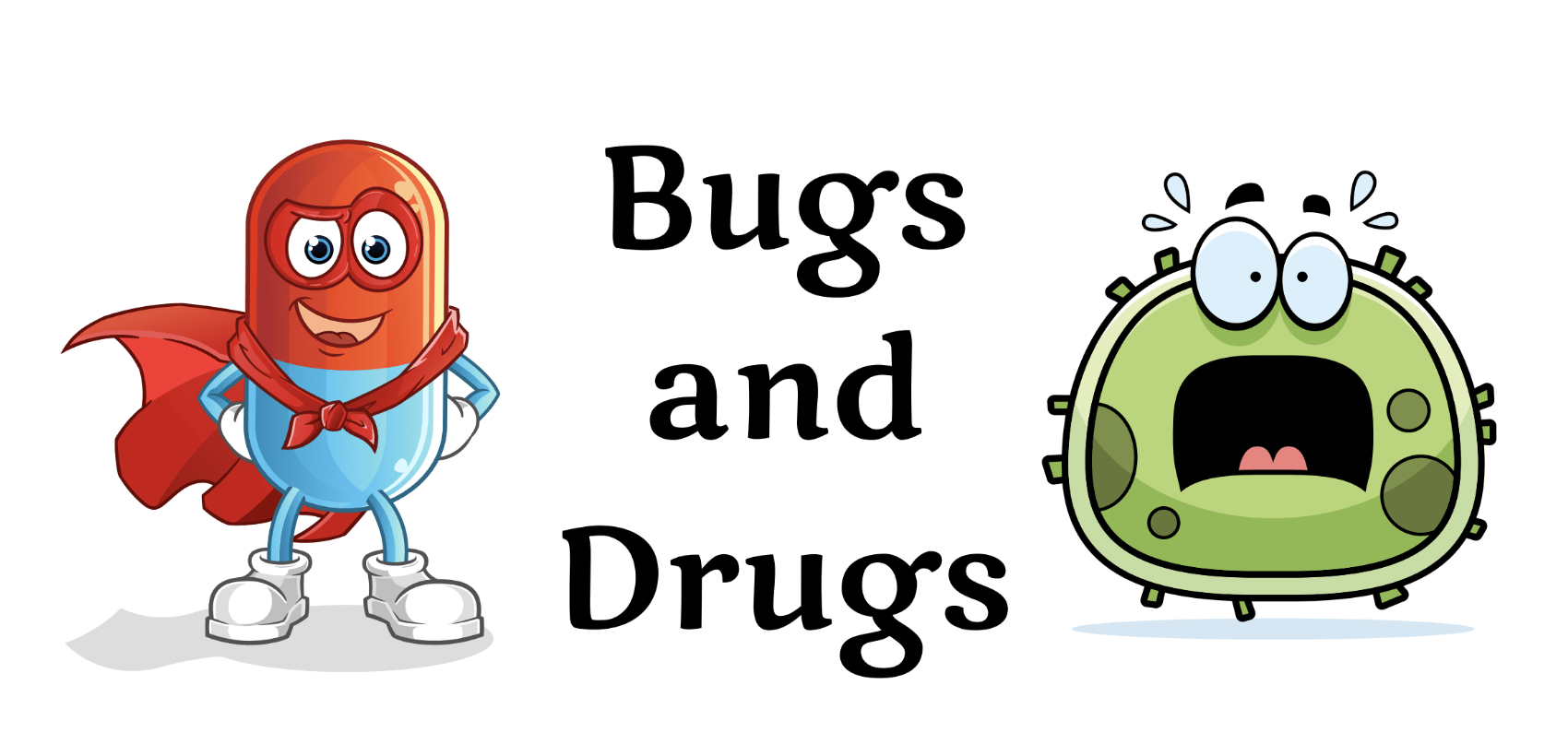Game Designer: Alex Youssef, Chinat Yu, Elyse Cornwall, Gwendolyn Liu
Overview
When you get sick, would you ever wonder about the teeny-tiny critters making you sick and the medicine battling them? Most of us don’t give it a second thought. We just dash to the doctor, grab our meds, and hope for the best. In today’s evolving global health landscape, antibiotic resistance emerges as a formidable challenge. However, a significant portion of the population remains unaware of the specific bacteria causing their ailments and the corresponding antibiotics designed to treat them. Not everyone has to become a doctor, but it is always important to stay informed!
Bugs and Drugs is a game that lets you dive into the world of bacteria infections. Throughout the game, you will learn about what antibiotics can treat your diseases and pick up some good healthy habits that can boost your infection-fighting game.
The target audience is biology and medical students (who may need to learn such material for school), but most importantly, it is for anyone who wishes to be educated on the topics of antibiotics and curious about ways to protect themselves against common infections. We believe that this game has a valuable outcome for casual players and study groups alike.
Bugs and Drugs can be played by 2-5 players, and is intended for ages 16+ due to the content of the game (STIs and deadly illness).
Games that are similar to Bugs and Drugs:
- Welcome to the Dungeon: We modeled our game mechanics off of this game, which involved pushing your luck until a single player was identified to challenge a set of monsters.
- Drugs vs. Bugs: The game has a similar theme but very different mechanics and dynamics. The game is a medical education game to raise awareness about antimicrobial resistance and over-prescription of antibiotics, rather than building associations between bacteria and effective antibiotics and healthy habits.
Types of Fun
Fellowship:
This game is competitive, and keeping one’s previous moves secret from the other players is a key dynamic of the game. To determine who will challenge the Infection Zone, players must take cues from one another, deciding when to pass based on when others do so. Players might bluff, pretending to put a damaging Bug Card into the Infection Zone to scare other players off. Sabotage is another dynamic that emerges when players intentionally “poison the well” by placing damaging Bug Cards into the Infection Zone, and then passing on a subsequent turn to avoid facing these infections themselves. Finally, players may behave altruistically and keep the Infection Zone as manageable as possible, even if they are doing so to increase their own persona’s chance of surviving.
Challenge:
Players push their luck each round by seeing how many Bug Cards they can place in the Infection Zone before all other players pass, choosing to keep their personas safe at home. The challenge emerges when players attempt to tally health points and identify useful Drug Cards, all while the moves of the other players remain unknown. Players may strategize to defeat the Infection Zone or force someone else into it, but ultimately, the fun emerges from the player’s attempts to overcome obstacles like Drug Cards and sabotage. Players were eager to play the next round as soon as the previous one ended, determined to adjust their strategy to challenge the Infection Zone next time. The challenge of defeating infections using luck and skill kept players engaged across many rounds, and this contributed to our learning goal of gradual familiarization with repetition.
Sensation:
During the game, players navigate a spectrum of emotions. They watch with rising tension as the Infection Zone accumulates a growing stack of cards, grappling with the anxiety of potentially being the one chosen to face the Infection Zone. As each Bug Card is unveiled, the selected challenger’s anticipation mounts. Victorious players experience immense pride, exemplified by our playtester, Amy, who boasts about surviving a formidable deck with just two points to spare. Yet, there are moments of shared camaraderie and light-hearted jest when a challenger fails, with fellow players playfully admitting, “I added that card, HAHA.” Based on our playtests, it’s evident that “Bugs and Drugs” takes participants on an emotional whirlwind with each round!
Rules
See here for the full rulebook (contains a demo video!)
Game Components
See here for a high-resolution version of all game components.
See here for a print-at-home version!
- A Play Mat
- Drug Cards (9)
- Bug Cards (24)
- Character Cards (5)
- Wellness Cards (20)
- Action Cards (15)
- Cheat Sheets (5)
Assessment Goals
Learning Outcomes for “Bugs and Drugs”:
- Educate players on proactive steps to enhance their overall health and well-being.
- Provide players, through repeated gameplay, with knowledge about various bacteria and the corresponding antibiotics that effectively treat the associated infections.
- Highlight and spread awareness about the pressing concerns of antibiotic resistance.
Assessment Methods:
To evaluate the efficacy of our game in achieving these outcomes, we employ two primary methods of assessment:
- Pre and Post-Game Survey:
- Before and after playing, participants are asked to complete a survey. This includes questions like:
- Can you name three antibiotics?
- Can you list three diseases caused by bacteria?
- Which antibiotics would you use to treat an ear infection, UTI, and gonorrhea?
- Before and after playing, participants are asked to complete a survey. This includes questions like:
- Post-Game Reflection Discussion:
- After gameplay, a facilitator-led discussion is conducted where players are prompted to reflect on:
- The healthy habits they’ve learned and feel they should incorporate into their lives.
- Their newfound or deepened understanding of antibiotic resistance and its broader implications on global health.
- After gameplay, a facilitator-led discussion is conducted where players are prompted to reflect on:
Educate players on proactive steps to enhance their overall health and well-being:
Through the inclusion of Wellness Cards in the game, players are consistently introduced to various healthy habits they can embrace for better well-being. Some Wellness Cards highlight familiar practices like frequent handwashing, while others spotlight habits that might be overlooked in daily routines, such as showering post-exercise or opting to walk or bike to work to boost physical activity.
In Playtest #3, #4, and #5, the groups shared that the game not only introduced them to new habits but also brought to mind beneficial habits they were aware of but hadn’t been consistently practicing.
Provide players, through repeated gameplay, with knowledge about various bacteria and the corresponding antibiotics that effectively treat the associated infections:
To emphasize the relationship between various diseases and their corresponding antibiotic treatments, we’ve intricately woven this into the gameplay using Bug Cards. Whether players are placing them into the Infection Zone, removing them, or taking on the challenge of the Infection Zone, they’re consistently referring to the Cheat Sheet, matching the appropriate antibiotic with the corresponding bacteria.
We recognize that the subject matter we’re presenting is technically nuanced and isn’t easily digested. Some of our playtesters voiced their struggles in retaining the information after just one or two game rounds. However, many also mentioned that since the game is highly replayable, they believe that with multiple plays, retention would inevitably improve.
Interestingly, even though some players may doubt their recall ability, we observed that as the game progresses, players become more familiar with the content. We noticed instances when, while one player was consulting the Cheat Sheet, another would already shout out, “That’s for Ampicillin!” The game’s pace noticeably accelerates with successive rounds, as players become less reliant on their Cheat Sheets.
From our evaluations, after only two rounds, players already showed marked improvement in answering questions like “Name 3 antibiotics” and “Name 3 bacterial diseases.” Recognizing bacteria-induced diseases and antibiotics is a significant step towards our ultimate objective: association. We were pleased to note that some players could even match common diseases like UTI and Chlamydia with their appropriate antibiotics. Given these promising indicators, we are optimistic that with consistent gameplay, our intended learning outcomes will be fully realized.
Highlight and spread awareness about the pressing concerns of antibiotic resistance:
By incorporating a resistance mechanism in the Drug Cards, we aim to educate players about the inherent limitations of antibiotics. While these drugs are potent, they are not infallible. In the game, players quickly learn that they cannot rely on abusing the power of antibiotics to win, as a resistance will certainly develop with time.
During Playtest #3 and Playtest #5, we prompted players to discuss their perceptions of antibiotic resistance post-gameplay. Universally, they recognized the dire implications of unchecked antibiotic resistance, understanding that many diseases could become untreatable. While the primary focus of our game isn’t to tackle antibiotic resistance, it effectively underscores the gravity of this looming global health crisis.
Iterations:
Prototype #1, Low-Fidelity
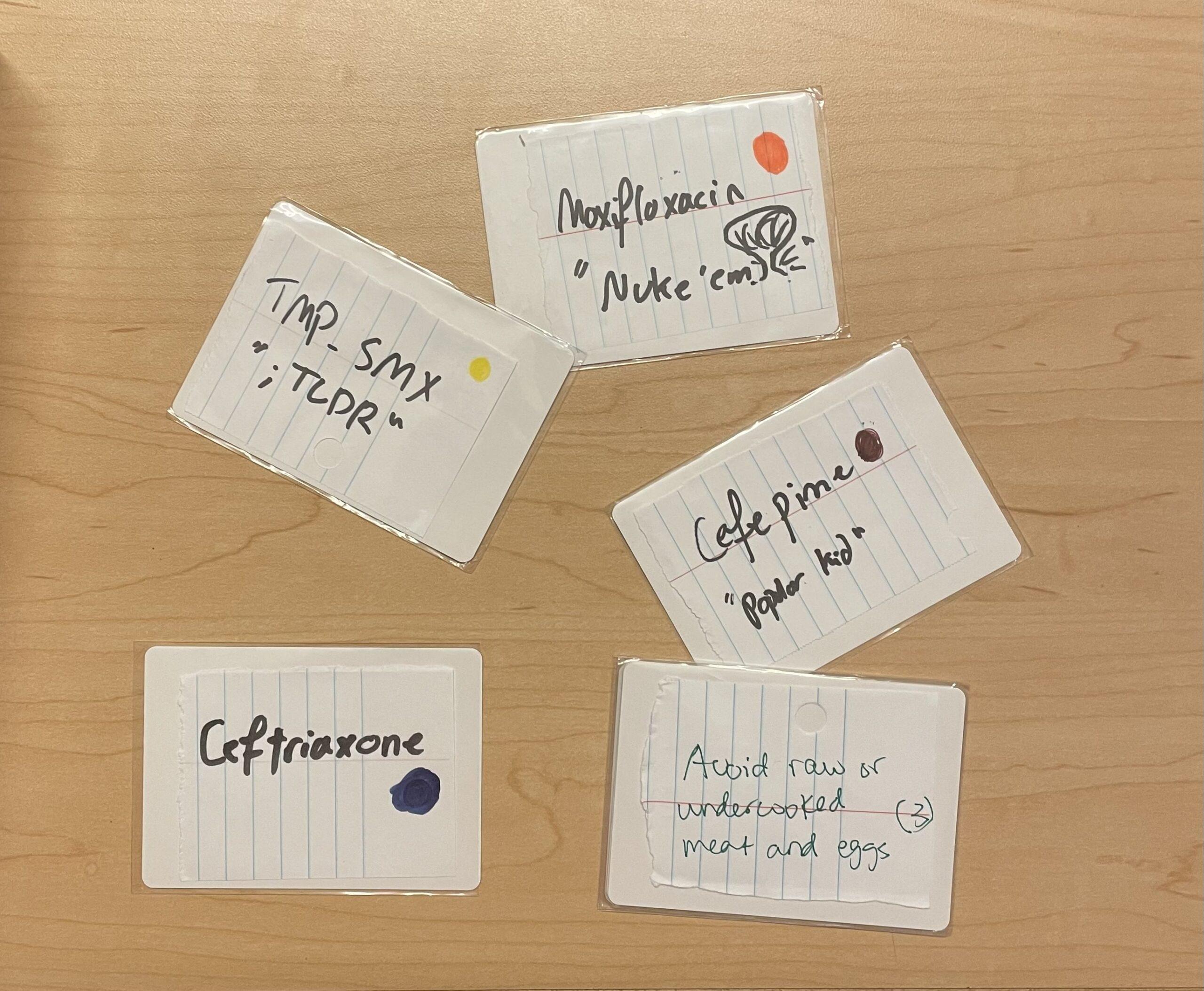
Key Characteristics:
- In the game’s initial prototype, our primary educational goal was to aid medical students in memorizing the associations between antibiotics and bacteria. To achieve this, we designed 21 distinctive Bug Cards featuring only their Latin names, and 10 Antibiotic Cards, each targeting three to five different bacteria.
- We incorporated the “push your luck” mechanism in gameplay. This was based on our belief that deciding where to position the Bug Cards (either placing them into the Infection Zone or removing them) and the act of challenging the Infection Zone would repeatedly expose players to the associations between various Bug and Antibiotic cards, thereby enhancing their learning experience.
- Furthermore, we introduced 12 Wellness Cards to award players with extra health points. By default, players begin with a base of 3 health points.
Playtest #1, 10/05/23
| Playtesters | Feedback | Changes we made |
| Our CS377 classmates, during 2B.4 players.
Ages 20-24. |
Players were intimidated by the game, since it seemed complicated and highly-technical.Instructions felt unclear and the goal of the game was not evident at the beginning. | Replaced latin names with common names on bug cards.Introduced cheat sheet for matching bugs to drugs. |
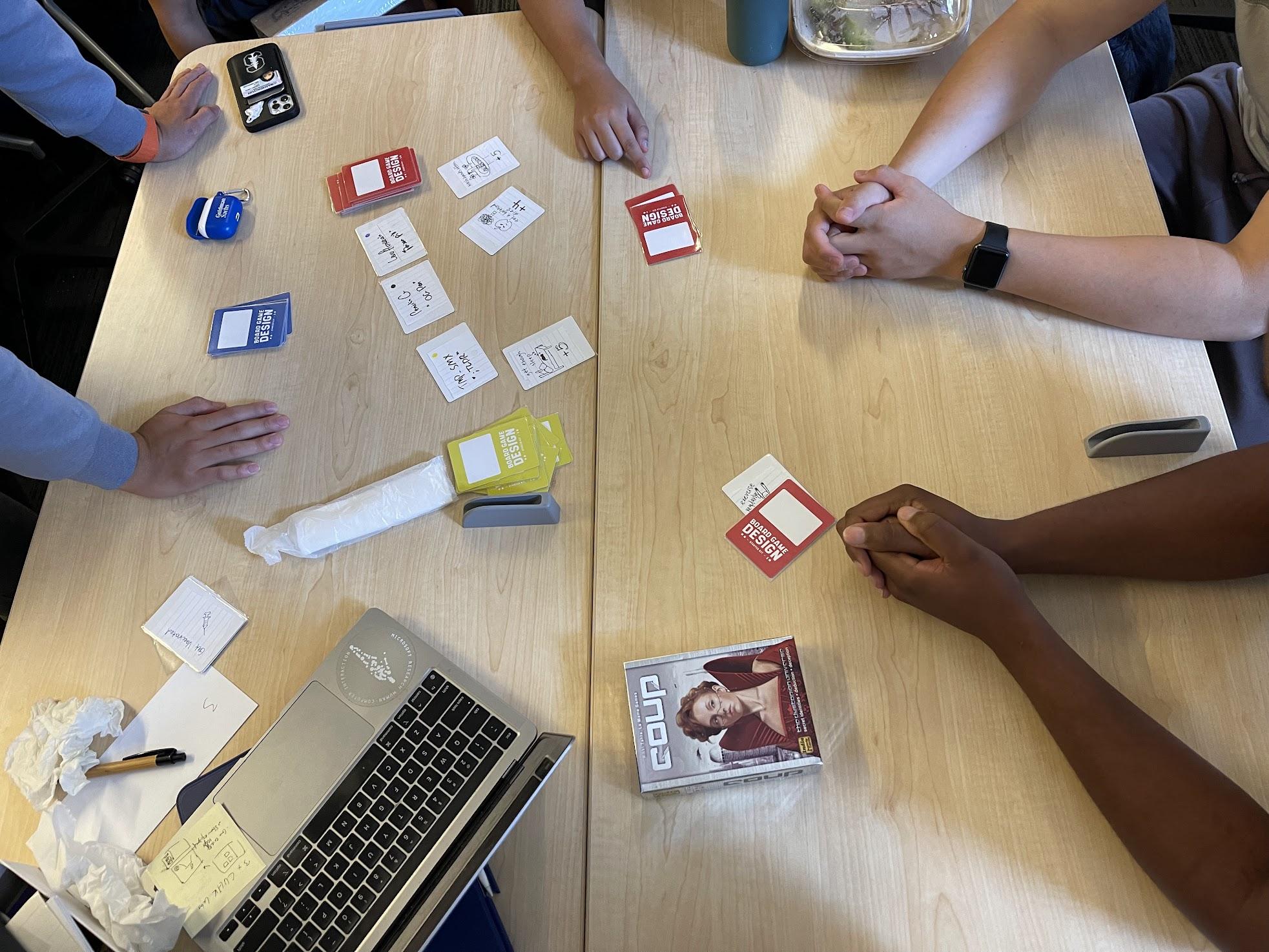
- We noticed that our classmates were hesitant to play our game based on its description, so it was clear that we needed to make our game feel more approachable. We debated abandoning antibiotics entirely and focusing instead on healthy habits, but we settled on revising the existing bugs. By replacing Latin names like “chlamydia trachomatis” with “pink eye,” we hoped to make our game more relatable to those who didn’t study medicine.
- We also reduced our set of Bug Cards from 21 to 14, identifying the most recognizable infections that still spanned from mild to severe.
- We also created a Cheat Sheet that students could use instead of relying on color matching to pair bugs and drugs, since playtesters expressed that it was difficult to form associations without seeing the terms next to one another.
Prototype #2, Low to Mid Fidelity
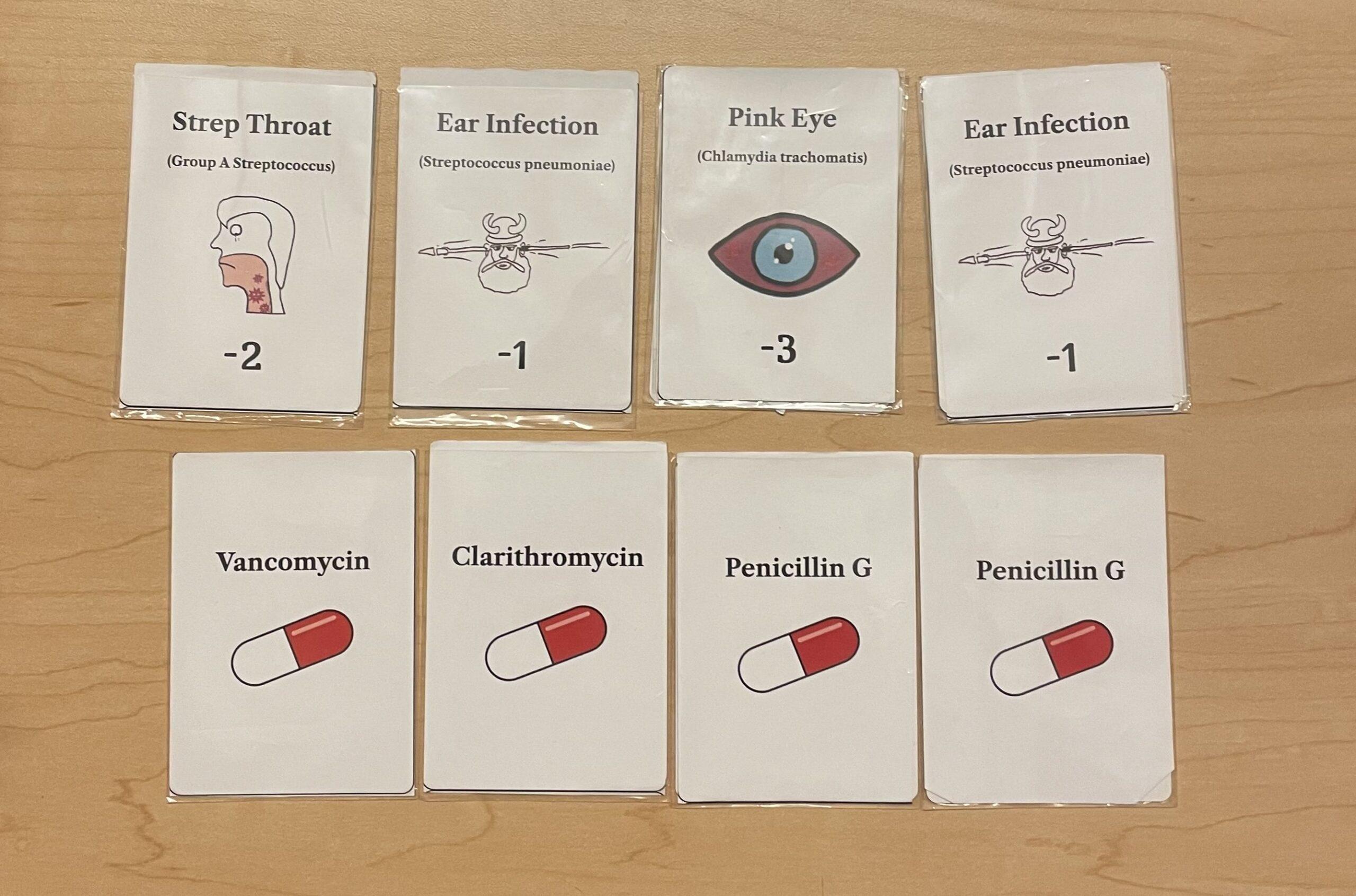
Key Characteristics (lots of changes happened in this iteration!)
- In this iteration, we pivoted our educational aim. Instead of targeting only medical students, our focus broadened to educate the general public on the importance of healthy habits to prevent bacterial diseases, while also introducing various bacterial infections and their associated antibiotic treatments.
- The number of bacteria have been streamlined, dropping from 21 to 14, with Latin names swapped out for more recognizable disease names. To make the game more playable, we also adjusted the distribution of the Bug Cards—instead of having each bug appear once in the deck, those with less deadliness level will now have more copies than those more deadly. As a result, we would have 24 Bug Cards (14 diseases/bacteria). We’ve added vivid illustrations to these cards, hoping to enhance their “fun” and memorability.
- Now that we had less Bug Cards and therefore less Drug Cards, we created duplicates for each Drug Cards so that each player could still be dealt three.
- A narrative layer has been added: we now have five distinct player characters, each with a base health ranging from 1 to 3 points. Wellness Cards have been tailored according to these characters’ unique strengths and lifestyles. In each round, all players adopt the role of a singular, central character.
- We’ve also introduced 5 Action Cards, such as “Get Vaccinated,” “Doctor Check-Up,” and “Health Insurance.” Players now receive 3 Wellness Cards and 1 Action Card at the start, selecting one to place in the ‘Healthy Habits Row’.
- To aid gameplay, a Cheat Sheet has been included, and we’ve decided to remove the previous color coding to amplify the learning curve.
Playtest #2, 10/10/23
| Playtesters | Feedback | Changes we made |
| Our CS377 classmates, during 3A.5 players.
Ages 20-24. |
Duplicate bug cards were frustrating.Hard to tell if the game is supposed to be competitive or cooperative. | Removed duplicate bug cards.Gave each player their own character card. |
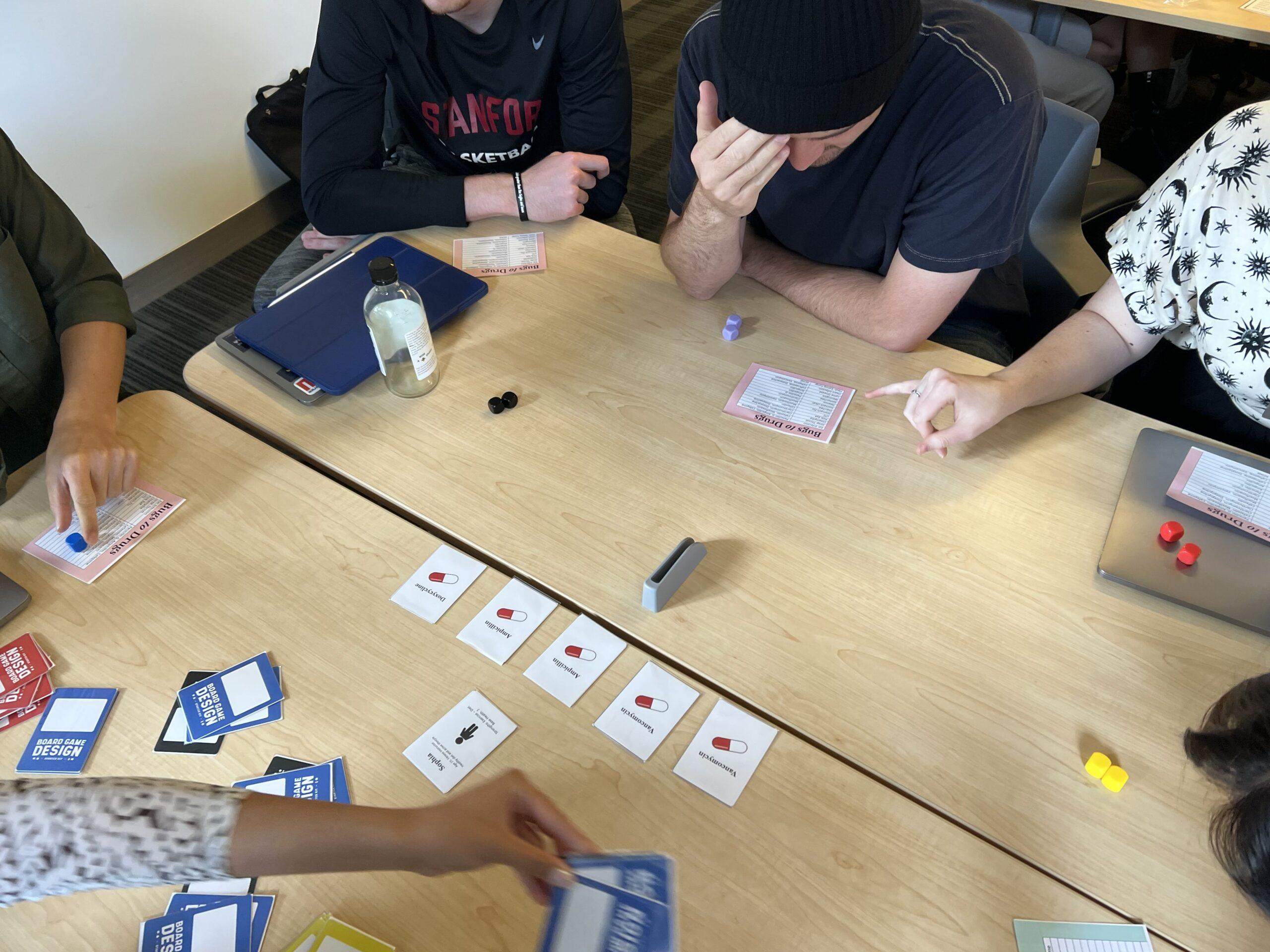
- Since there were duplicate drug cards, it was common that two players would select the same drug, restricting the range of bugs that they had access to when challenging the Infection Zone. Given that each drug card became resistant after defeating two bugs, duplicates had the small benefit of offering immunity against 4 cards for this drug rather than 2, but players found this situation undesirable and unnecessary overall. We decided to have 9 cards, all of which were unique, rather than 21 with duplicates. This meant that we would randomly select 5 cards for the Pharmacy, rather than having players each select from several.
- Our playtesters also expressed confusion about two contradictory play styles in the game. Given the shared resources in the Pharmacy and Health Habits Row, it seemed that they needed to cooperate with other players. On the other hand, only one person could win the game and players could sabotage their teammates by “poisoning the well” with a high-damage bug card, and passing on their next turn. This also made the narrative unclear – were they trying to save or kill the central character? People expressed resistance to the act of “killing the central character,” saying things like “We don’t want Sophia to die!”
- To clarify the narrative and encourage a competitive play, we decided to give each player their own Character Card, instead of having one central character for the round. Each player would compete to protect their own character from bugs spread around (put into the Infection Zone) by the other characters. In this case, each player will gain additional bonus points if the Healthy Habits Row contains Wellness Cards that align with their character’s strengths, should they be the one to challenge the Infection Zone.
Playtest #3, 10/10/23
| Playtesters | Feedback | Changes we made |
| A group of friends, compensated with ice cream!3 players.
Ages 20-22. |
One character card per player heightened competition.The game took too long to win.
Each player should get a special action card rather than having them laid out in the middle |
Continued to deal one character card to each player.Changed the win condition from 3 points to 2 points.
Dealt action card to players at the start of each round. |
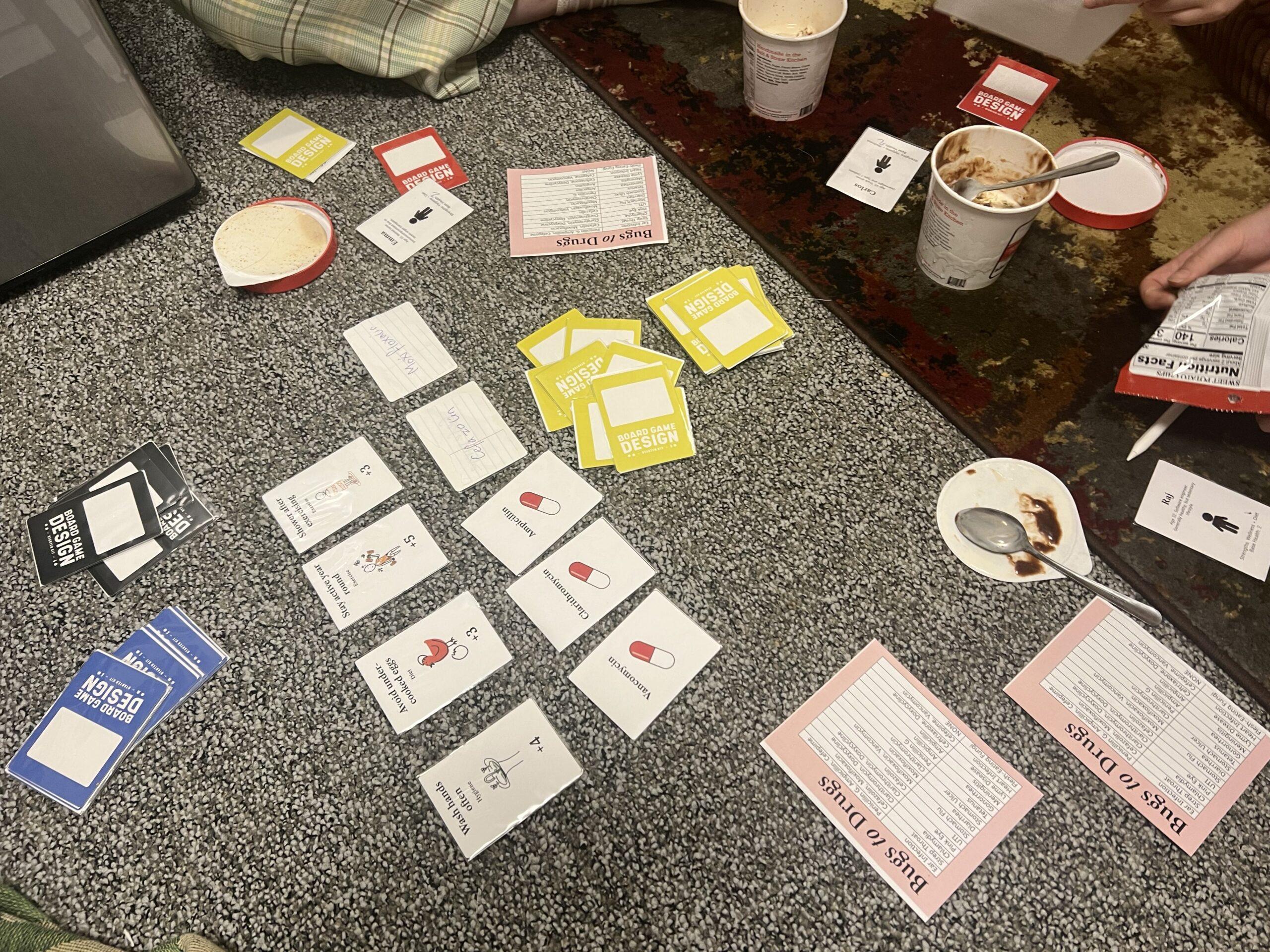
- In this playtest, we took advantage of the time outside of class to play many rounds of the game. We have initially specified that to win the game, one must get 3 points (you win a point if you successfully survive the Infection Zone, and lose a point if otherwise). We noticed that the rounds were split evenly between wins and losses – nobody reached the win condition because players could easily lose any points they had earned. To remedy this, we considered different win conditions, for example:
- Starting with two points per player and losing if you reached 0 (-1 for losing in the Infection Zone, no plus point for winning a round)
- We realized that players will then have no incentive to challenge the Infection Zone.
- Counting winning points without ever losing points for losing in the Infection Zone
- However, this will give no penalty for losing at all
- Ultimately, we re-defined the win condition as: each player will have 2 points to begin with. They will lose a point if they lose in the Infection Zone (losing all your points result in termination from the game) and they will win a point if they succeed. The player first to reach 4 points will win the game.
- Playtesters also said it didn’t make sense to mix Action Cards with Wellness Cards; instead, those should be a hidden card for each player that they could use if they were to go into the Infection Zone. We really like this idea because it encourages players to think strategically and incentivizes them to go into the Infection Zone.
Playtest #4, 10/11/23
| Playtesters | Feedback | Changes we made |
| Classmates, CS377 Game Night!4 players.
Ages 20-24. |
Base health should be higher, since players were losing more often than not.Drug cards looked too similar (same red/white pill on each) which made them hard to distinguish.
The adjusted win state was still confusing. Setup takes a long time. |
Gave each player between 9 and 11 base health points.Added colored pill bottles to assign a color to each drug. Focused on rounds rather than the scheme of tallying points.
Introduced a playmat and added many diagrams to our rulebook. |
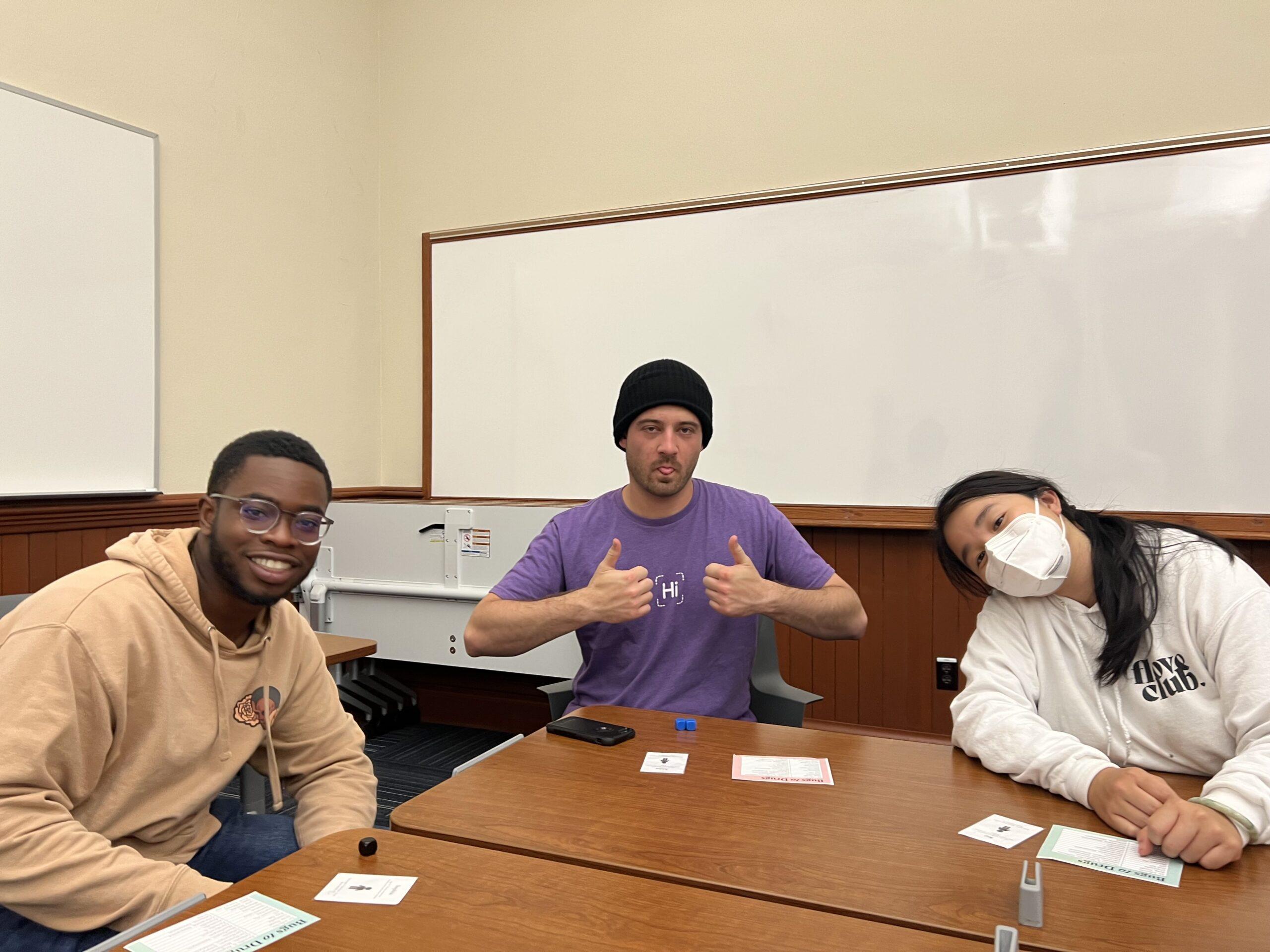
- This group of players was extremely competitive, and took advantage of the ability to sabotage others by “poisoning the well.” In this playtest, players tended to stay in the game longer, only passing after the Infection Zone seemed very difficult to challenge, which resulted in more losses. We decided to add to the base health of each player, so that they ranged from 9-11 instead of 1-4.
- Players found selecting wellness cards based on their character’s strengths to be tedious, so we removed the strengths from the Character Cards so that any card could be dealt to any player.
- While we had moved away from color coding our bug and drug pairs in earlier rounds, our feedback suggested that we reintroduce color coding. After the information design lecture, we were wondering whether color associations might actually help with the learning rather than distract from it. We added colored pill bottle icons to the upper right corner of each bug card, to show which drugs could defeat it. Each drug was assigned a color, so that the different drugs stood out from one another. In the long term, players might form associations between the drug and its color, which could help with memorization.
- Even as we had made the win state more achievable, players felt unsure about what strategy to pursue because they could win both by earning points and by sabotaging others. They suggested several ways, such as giving a small penalty when players choose to pass, and giving more points to challengers who survive more Bug Cards.
- After a team discussion on defining the winning state, we came to the conclusion that we should focus on defining the win state for each round and allow players to define their own methods of tallying points. For example, a newer audience might simply tally wins across rounds, while a more competitive group might penalize passing as well as losing in the Infection Zone. We changed our rules according to this and tested this in our final playtest.
Prototype #3, Mid to High Fidelity
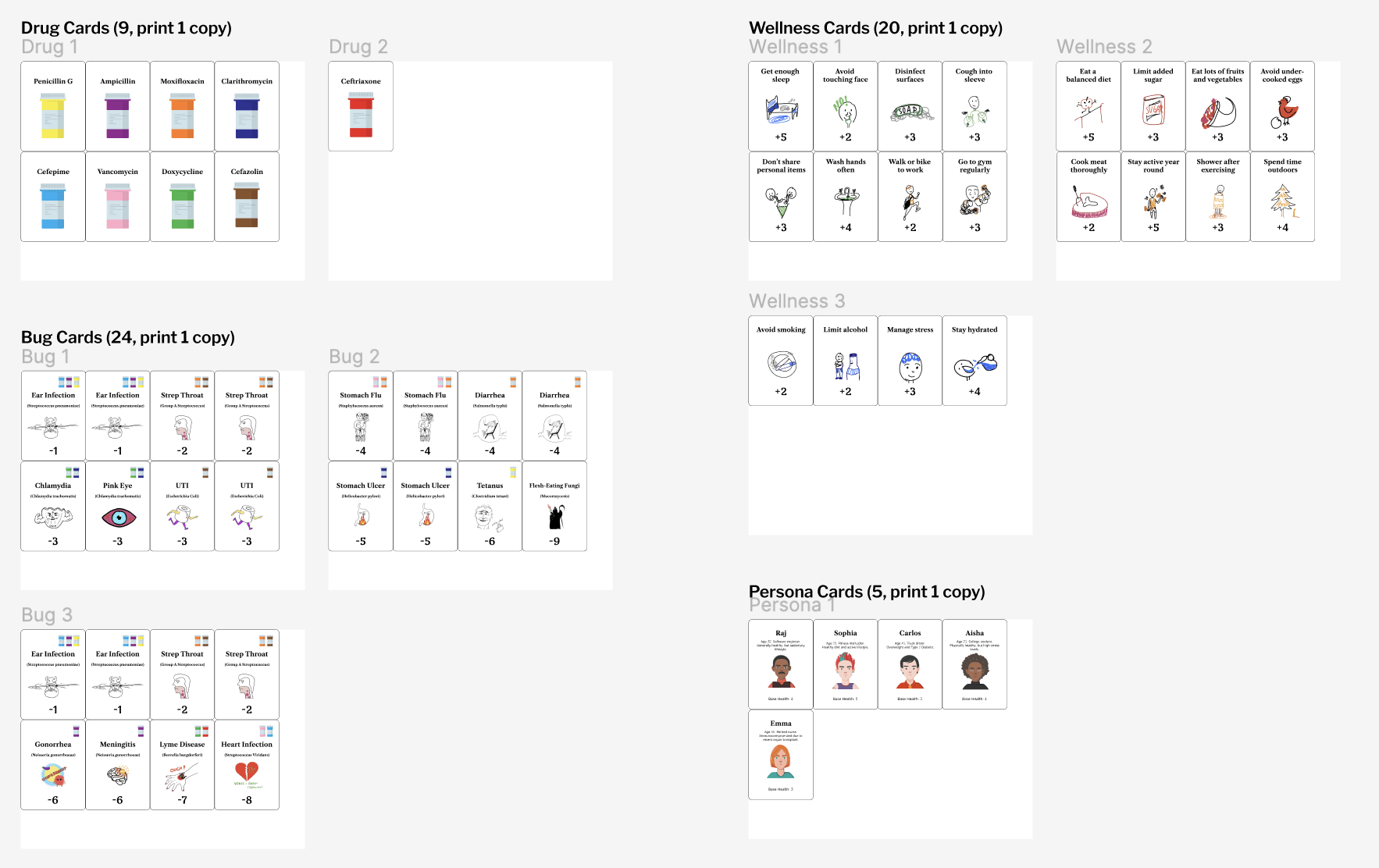
Key Characteristics:
- A rulebook with diagrams illustrating how each step of the game should be played. Winning state is defined by round, with additional suggestions on how players could tally points to play multiple rounds.
- Each player receives one Character Card (now illustrated!) with base health ranging from 9-11.
- Drug Cards are illustrated with a specific color. Bug Cards are illustrated and color-coded to match their corresponding Drug Cards.
- Categories for Wellness Cards are completely removed.
- Players receive 3 Action Cards at the beginning and they could choose one to use for the Infection Zone later.
- A Play Mat is created to help players clarify the set-up stage of the game.
- Distribution of Bug Cards is added to the Cheat Sheet to assist players’ strategy.
Playtest #5, 10/12/23
| Playtesters | Feedback | Changes we made |
| Our CS377 classmates, during 3A.5 players.
Ages 20-24. |
Base health of 9-11 is too many.Setup is now easy, but the first round is difficult.
The narrative could be made even clearer. |
Reduced base health to 3-5.Created setup video and simplified rules.
Wove narrative more clearly into rules and terminology. |
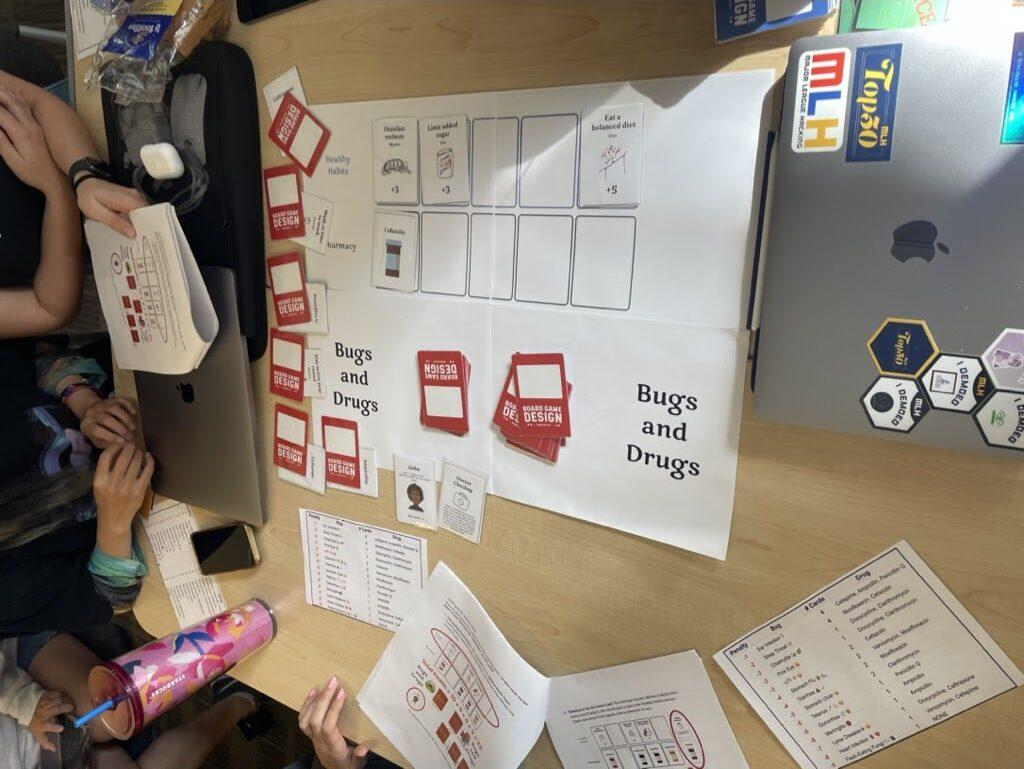
- The group acknowledged that our game is complex and well designed. They loved the way we designed our different game components. They also believed this game was highly replayable, and they were eager to continue playing after they fully understood the rules.
- The setup of the game went quickly and smoothly, thanks to the playmat and clear setup instructions in our rulebook. However, it is suggested to us that we could streamline the set-up process even further by having players randomly select Wellness Cards as a group. Most of their confusion stems from not being able to understand the rules of gameplay. In Particular, because of the non-linear nature of our game, you need to have understood how one challenges the Infection Zone (the last step) before being able to develop strategies when drafting the Bug Cards (the intermediary step). Reading the rulebook section by section is confusing since the overall strategy is unclear. Therefore, players were hesitant to begin the gameplay because they didn’t understand how their actions in the first phase of the game would impact their ability to challenge the Infection Zone. They had no concept of the Infection Zone or strategy for later in the game, since they hadn’t seen this battle play out before.
- We decided that a demo video was crucial, and in particular, the video should start by explaining how players will challenge the Infection Zone, so that the strategies for the first phase of the game made sense. Across all of our playtests, the first round required lots of hand-holding (either by our team or a more experienced playtester) but after seeing how the round ended, players grasped the game quickly and began to compete. The focus of the video was getting players through the first round faster and with less confusion.
- What we have come to realize is that the gameplay experience of our game is highly dependent on the group dynamics. We had come a long way and made many revisions, but it seemed that every group that played got very different results in terms of win percentages and dynamics. The competitive group felt that 10 health points per player would be perfect, whereas the players in this final playtest were hesitant to sabotage, and ended up with many points to spare after challenging the Infection Zone. In some ways, we liked how each group of players put their own spin on the game, but it made point values difficult to calibrate. In our final iteration, we landed on base health values between 3-5, a happy medium between the two extremes we had seen in playtesting.
- Finally, players identified ludonarrative dissonance between the competitive nature of the game and the concept of keeping people healthy. Why would anyone sabotage or add bugs to the pile at all if we’re learning how to stay healthy? To remedy this, we decided to give a narrative that helps contextualize each gameplay action of the game. For example: the act of passing simulates the act of staying at home to avoid illness—you won’t catch the diseases, but you miss out on the fun social aspect of life. The act of challenging the Infection Zone is similar to fighting illnesses—either you get to go out and stay healthy and live life, or you get sick, which is the worst option! We also make the competitive nature of the game very explicit in the rules and terminology.
Prototype #4, High Fidelity + Final Version
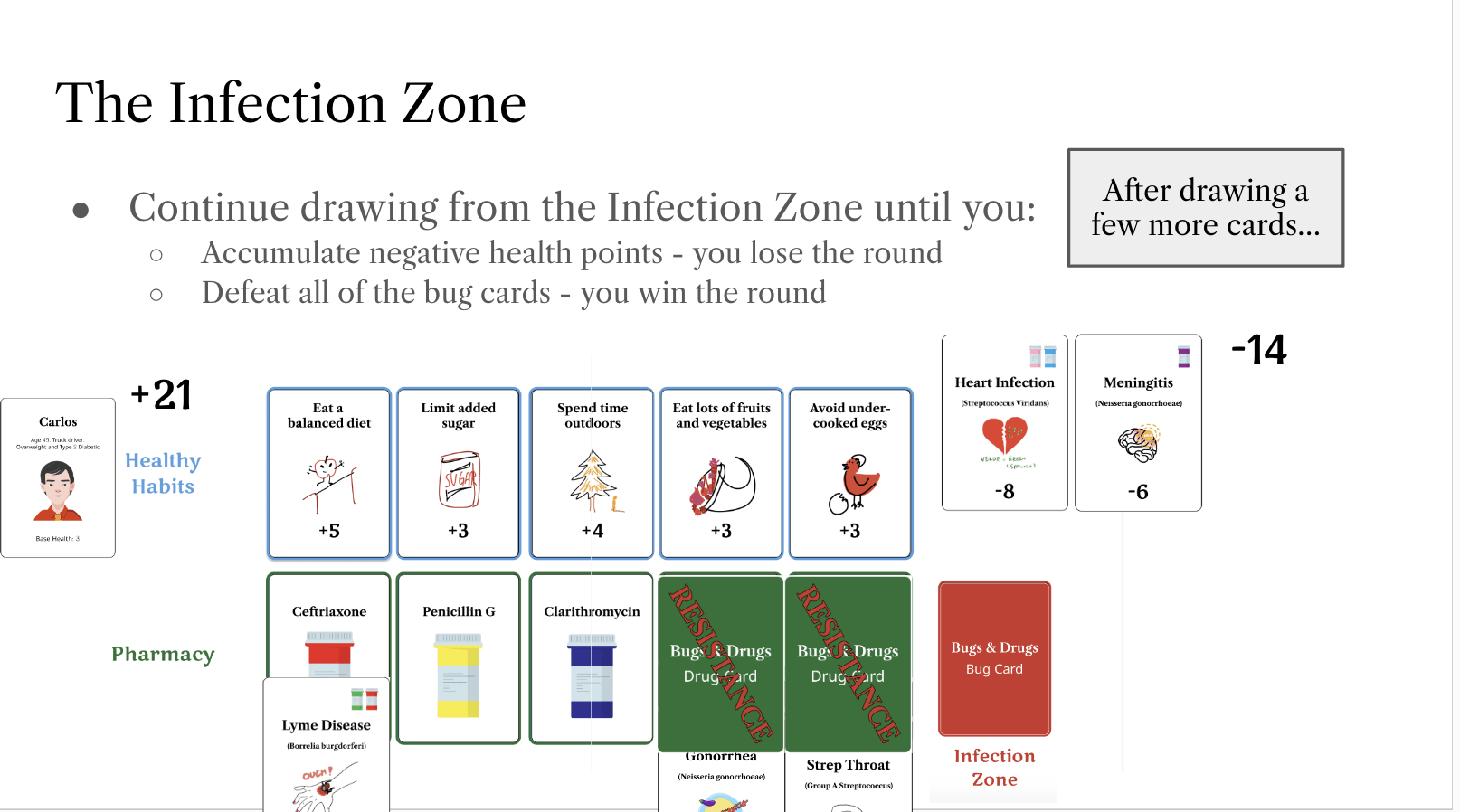
Everything mentioned above + a demo video!!!
Playtest #6, 10/13/ 23
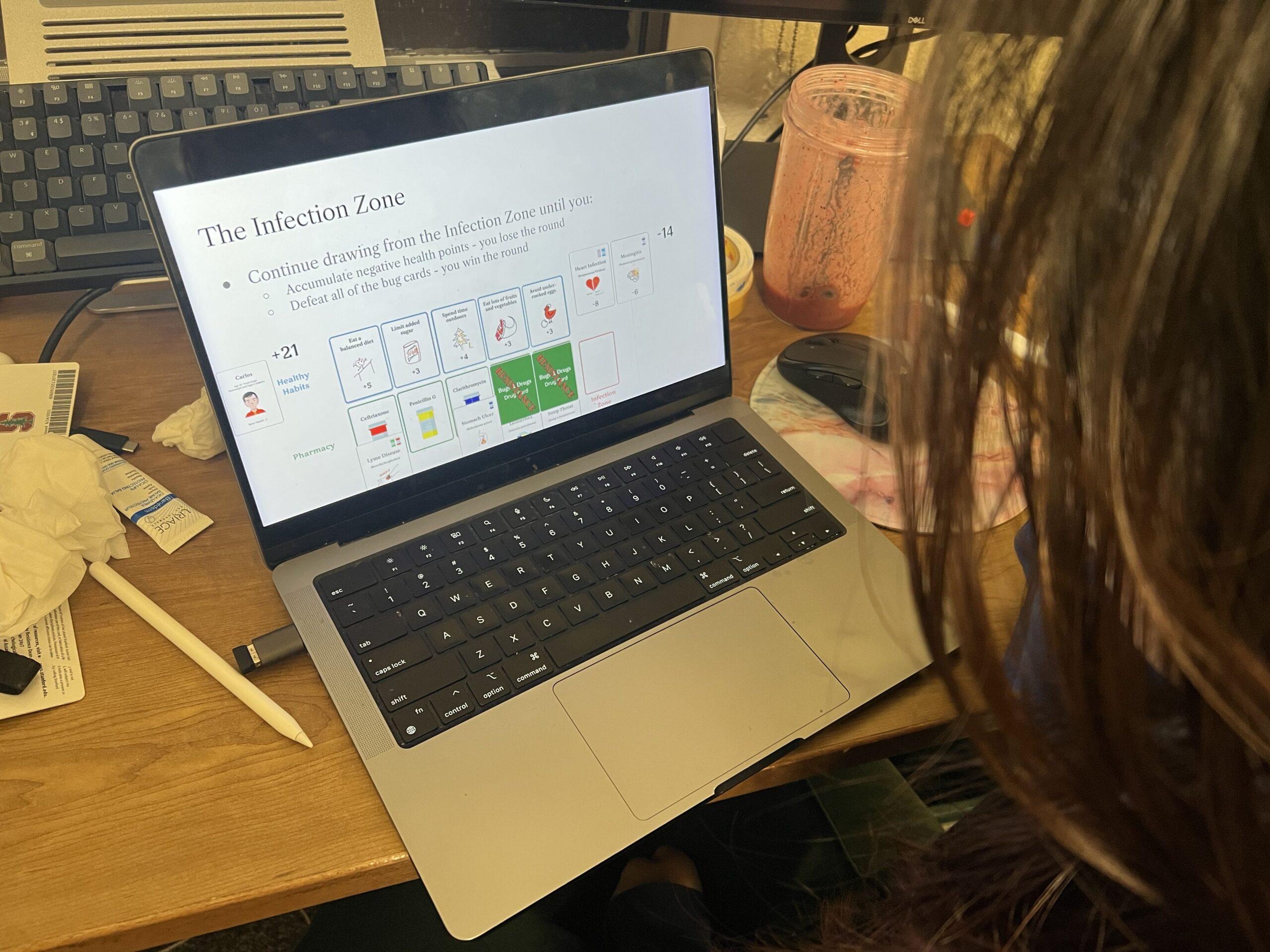
Knowing that our game components are pretty solid, we decided to do another playtest focusing solely on the delivery of our rules. This playtest was done with a group of friends (3 players; Age 20-22). Due to a shortage of time, no actual game was played. Players watched the video and read the rulebook; then they were asked if they understood how the game should be played.
Even though the video is quite long (13 minutes), they were happy to watch it at 1.5x speed and were able to absorb the rules in a much quicker manner. They then read over the rulebook and felt that it was a good supplement to the video, although the video would definitely be more useful if they were to play this game for the first time.
We received positive feedback on the narrative of the story —drawing connections from real-world scenarios (e.g. staying at home vs. going out when some infectious diseases are going around in the neighborhood), they were able to understand the strategies of the game and make decisions accordingly. We were happy to see that we finally managed to remove the painful “first round” in which players were just confused about the rules and strategies.
Reflection:
We recognize that our game is not perfect. With more time and more playtesting, we would love to refine our rules further, particularly in terms of winning state, if the game were to be played multiple rounds. At this stage, we’ve chosen to offer this as an optional rule for players to explore and unleash their creativity. All in all, we’ve made substantial progress in transforming our once “intimidating” medical game into an enjoyable experience where players unwittingly learn about bacteria and antibiotics. We are very proud of our work and the many iterations we made to make this possible!


